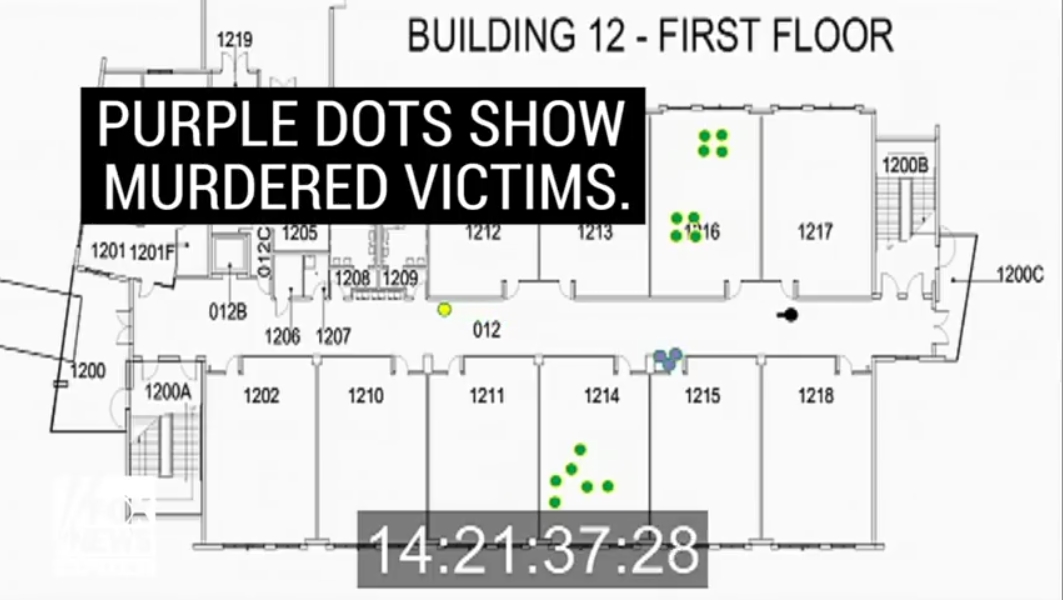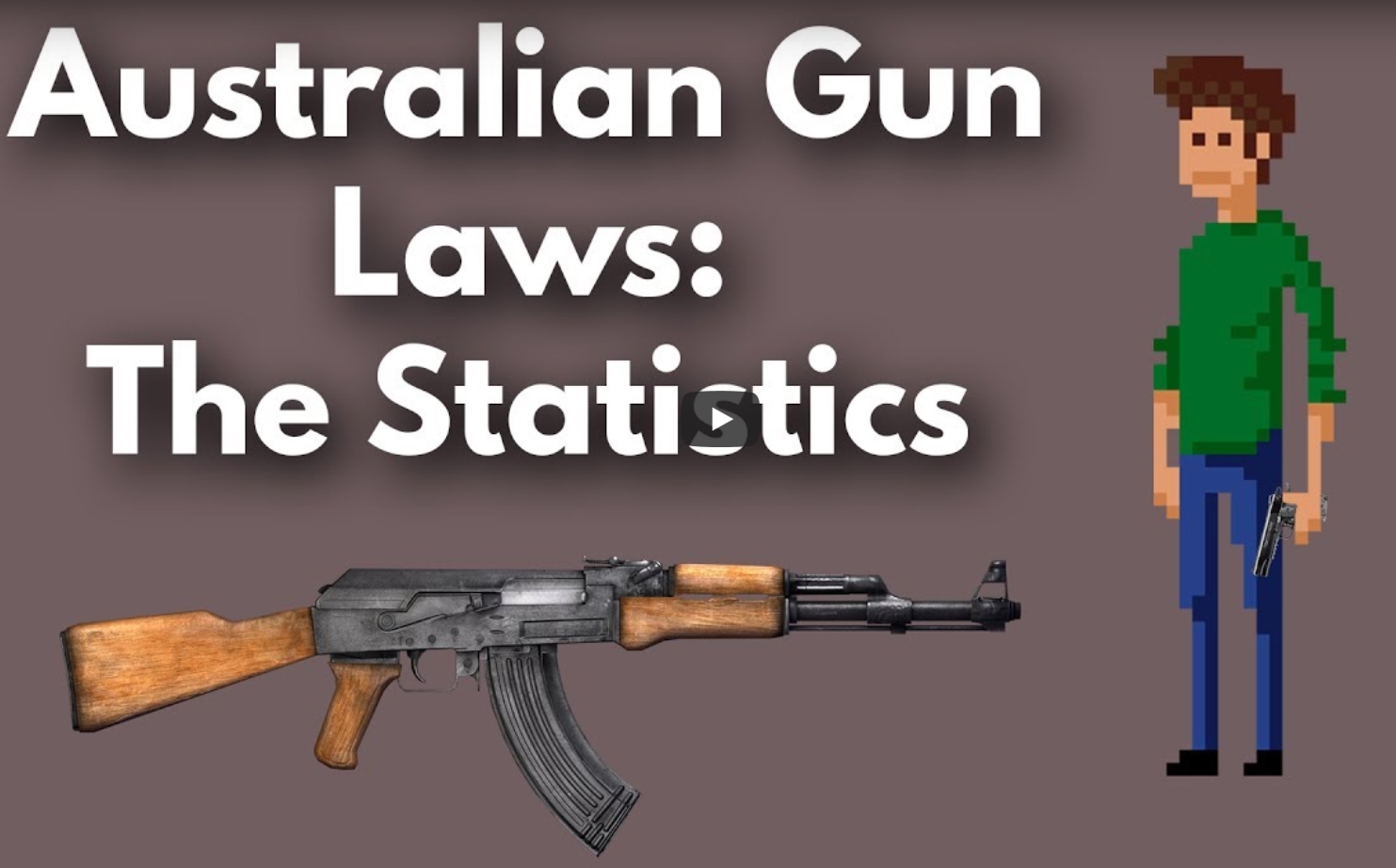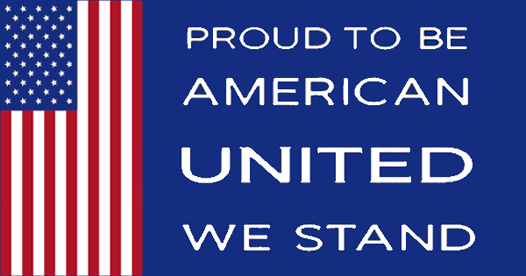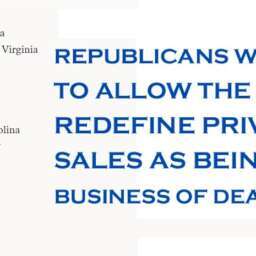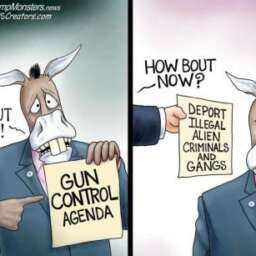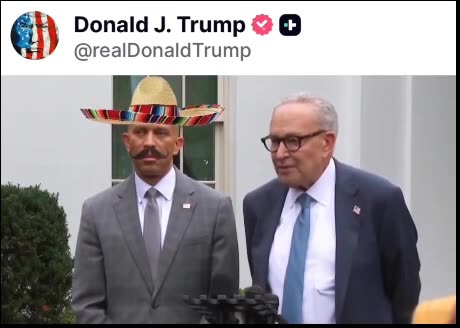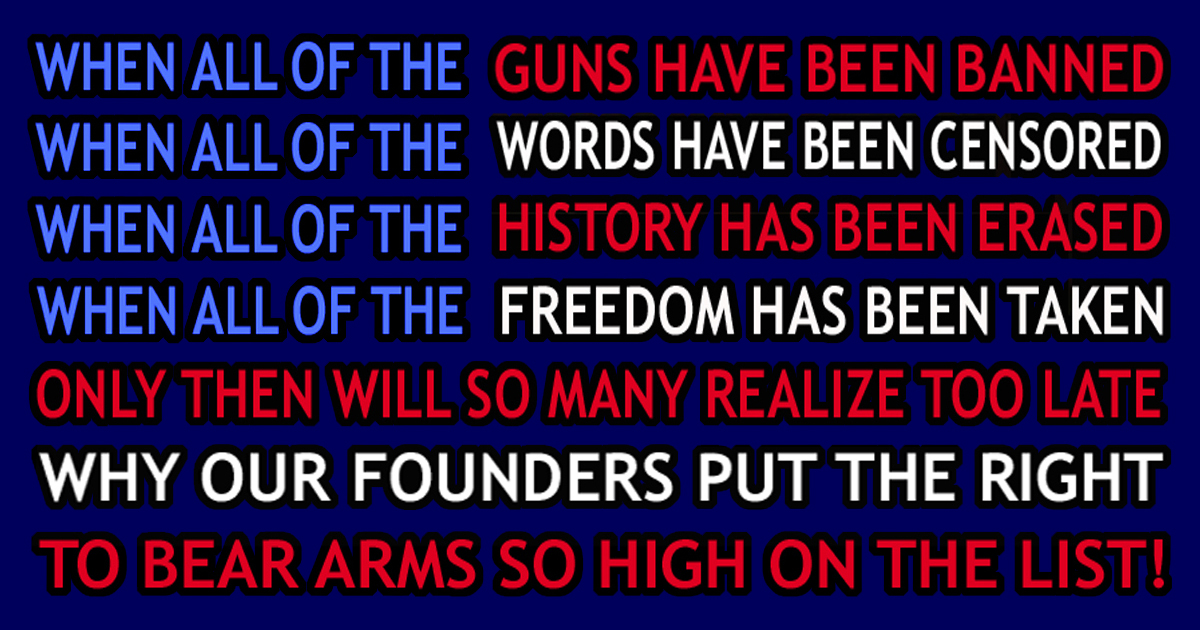Not only were it’s school staff defenseless because it is a gun free zone, the Marjory Stoneman Douglas High School design is like a shooting gallery. This horrifying animation created by the Broward Sheriff’s Office recreates shooter Nikolas Cruz’s actions inside the school on February 14, 2018. The missed opportunities that law enforcement or armed security could have had to engage this shooter are now completely irrefutable.
President Trump signs executive order enhancing current military rifles
American troops will be overjoyed knowing that their president takes their ability to defend us from foreign and domestic enemies seriously!
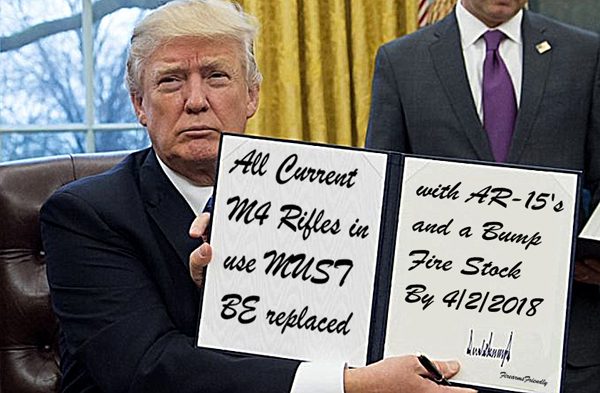
He just as well right? Considering the AR15 and Bump Fire Stocks are considered weapons of war and all that jazz. If you can’t see that this is obviously satire, you shouldn’t be allowed to internet. Or is it #AprilFools? 🙂
Australian Gun Laws & The Misconception That Gun Control Has Lowered The Number of Shootings [Video]
Australian Gun Laws: The Statistics – This video discusses the statistics both before and after the change in Australian gun laws in the late 90’s and tries to determine if they have been successful or not. Watch the video, comment and share your thoughts about it below.
Only 0.38% of American Population Participated in “March For Our Lives” Gun Control Efforts
 NBCMontana – 1.25M participated in March for Our Lives protests across US
NBCMontana – 1.25M participated in March for Our Lives protests across US
“WASHINGTON (CIRCA) – Two researchers say that over 1.25 million people across the U.S. participated in protests related to the March for Our Lives, according to Mashable.
Mashable on Tuesday reported that if the estimate proves accurate it would rank March for Our Lives events among the largest youth-led protests since the Vietnam War.
Researchers Erica Chenoweth and Jeremy Pressman of the Crowd Counting Consortium generated the estimate for last Saturday’s wave of demonstrations nationwide.
The protests were inspired by the main March for Our Lives event in Washington, D.C. demanding lawmakers combat gun violence.
Chenoweth and Pressman said that there were 521 protests linked to March for Our Lives across America.
The pair added that there were 27 related events overseas, far behind the 261 international demonstrations associated with the 2017 Women’s March.
March for Our Lives’ estimated 1.25 million people would rank it among the biggest protests in American history overall.
The Washington Post reported in 2017 that around 4,157,894 people participated in events linked to the Women’s March that year.
The total, if accurate, would make the flood of 2017 Women’s March protests nationwide the largest single-day demonstration in recorded U.S. history.
Vox reported last January that roughly 1.6 million to 2.5 million people took part in 2018 Women’s March events nationwide last year.
Chenoweth and Pressman said that their best guess for Saturday’s turnout in just D.C. is about 471,000 people.
The pair used a 10 percent deduction of the highest estimated count averaged with a 10 percent boost to the lowest estimate to arrive at their total.
Digital Design and Imaging Service – which deploys drones to collect aerial date – estimates Saturday’s protest in D.C. attracted about 202,000 people.
March for Our Lives organizers, in contrast, estimated turnout around 800,000 people, citing RSVPs and public transportation use data.
Last weekend’s march in D.C. was organized by students who survived a February school shooting in Parkland, Florida.
Seventeen people were killed in the Feb. 14 attack at Marjory Stoneman Douglas High School, reigniting national debate over gun control.”
Gun-control lobby is no longer distancing themselves from the radical idea of repealing the Second Amendment
 PBS – How difficult would it be to repeal the Second Amendment?
PBS – How difficult would it be to repeal the Second Amendment?
“Retired Supreme Court Justice John Paul Stevens called for the repeal of the Second Amendment on Tuesday, wading into the charged political debate over gun control that was reignited by several mass shootings in recent months.
It’s a familiar appeal from the 97-year old jurist, who was named to the bench by President Gerald Ford in 1975 and retired in 2010. But Stevens renewed his plea in an op-ed in the New York Times, three days after activists staged massive gun control demonstrations in Washington, D.C., and in other cities around the country and world over the weekend. Stevens praised the protesters for demanding reforms to current gun laws, but said they should go further.
“The demonstrators should seek more effective and more lasting reform. They should demand a repeal of the Second Amendment,” Stevens wrote.
Repealing the amendment, Stevens said, would effectively overturn the controversial 2008 Supreme Court ruling D.C. v. Heller, which found that the Second Amendment protected “an individual right to possess a firearm” for the purpose of self-defense.
In his op-ed, Stevens, who dissented in the 5-4 decision, wrote that the ruling gave the National Rifle Association “a propaganda weapon of immense power.”
He added: “Overturning that decision via a constitutional amendment to get rid of the Second Amendment would be simple and would do more to weaken the NRA’s ability to stymie legislative debate and block constructive gun control legislation than any other available option.”
So, what would the process of repealing the Second Amendment actually look like?
For starters, it would require the ratification of another amendment. This isn’t an easy step, but it’s been done before: After the U.S. prohibited alcohol sales in the 18th Amendment, the country later repealed the controversial amendment about a decade and a half later, with the 21st amendment.
There are two pathways for proposing another amendment. In the first scenario, Congress proposes an amendment with a two-thirds majority vote in the House and Senate.
The other option is for two-thirds of state legislatures — that’s 34 states — to call a constitutional convention. In both scenarios, three-fourths of the states — 38 states — would have to give their stamp of approval to ratify the proposed amendment.
So far, however, none of the 27 amendments to the Constitution have come out of the constitutional convention process. And remember in its 223-year lifespan, the Constitution has been amended only 27 times. The last amendment, concerning U.S. legislators’ salaries, was ratified in 1992.
What’s next?
The social media reaction to Stevens’ suggestion was swift.
Some scholars noted that Stevens’ op-ed could be counterproductive to legislative efforts to regulate guns, which would have broader public support than repealing the Second Amendment. While only about a fifth of Americans support repealing the Second Amendment, according to a February Economist/YouGov poll, about 60 percent of those polled said they favored stricter gun laws.
“To frame it as we can only have gun regulations if we repeal the #2Amendment” is not only wrong as a matter of constitutional text & history but also sets the movement up for failure,” the legal expert Elizabeth Wydra tweeted.
Josh Chafetz, a professor at Cornell Law School, said that Democrats could focus their energy instead on winning back the White House and Senate. Then, they could “appoint judges who share Stevens’s views and who will therefore narrow and eventually overturn Heller,” Chafetz wrote in a tweet. .
In a statement Tuesday, NRA Executive Director Chris Cox called Stevens’ proposal a “radical idea.”
Stevens’ arguments is evidence that “the gun-control lobby is no longer distancing themselves from the radical idea of repealing the Second Amendment and banning all firearms,” Cox said.”
The Assault Weapon Myth
 New York Times – The Assault Weapon Myth
New York Times – The Assault Weapon Myth
“OVER the past two decades, the majority of Americans in a country deeply divided over gun control have coalesced behind a single proposition: The sale of assault weapons should be banned.
That idea was one of the pillars of the Obama administration’s plan to curb gun violence, and it remains popular with the public. In a poll last December, 59 percent of likely voters said they favor a ban.
But in the 10 years since the previous ban lapsed, even gun control advocates acknowledge a larger truth: The law that barred the sale of assault weapons from 1994 to 2004 made little difference.
It turns out that big, scary military rifles don’t kill the vast majority of the 11,000 Americans murdered with guns each year. Little handguns do.
In 2012, only 322 people were murdered with any kind of rifle, F.B.I. data shows.
The continuing focus on assault weapons stems from the media’s obsessive focus on mass shootings, which disproportionately involve weapons like the AR-15, a civilian version of the military M16 rifle. This, in turn, obscures some grim truths about who is really dying from gunshots.
Annually, 5,000 to 6,000 black men are murdered with guns. Black men amount to only 6 percent of the population. Yet of the 30 Americans on average shot to death each day, half are black males.
It was much the same in the early 1990s when Democrats created and then banned a category of guns they called “assault weapons.” America was then suffering from a spike in gun crime and it seemed like a problem threatening everyone. Gun murders each year had been climbing: 11,000, then 13,000, then 17,000.
Democrats decided to push for a ban of what seemed like the most dangerous guns in America: assault weapons, which were presented by the media as the gun of choice for drug dealers and criminals, and which many in law enforcement wanted to get off the streets.
This politically defined category of guns — a selection of rifles, shotguns and handguns with “military-style” features — only figured in about 2 percent of gun crimes nationwide before the ban.
Handguns were used in more than 80 percent of gun murders each year, but gun control advocates had failed to interest enough of the public in a handgun ban. Handguns were the weapons most likely to kill you, but they were associated by the public with self-defense. (In 2008, the Supreme Court said there was a constitutional right to keep a loaded handgun at home for self-defense.)
Banning sales of military-style weapons resonated with both legislators and the public: Civilians did not need to own guns designed for use in war zones.
On Sept. 13, 1994, President Bill Clinton signed an assault weapons ban into law. It barred the manufacture and sale of new guns with military features and magazines holding more than 10 rounds. But the law allowed those who already owned these guns — an estimated 1.5 million of them — to keep their weapons.
The policy proved costly. Mr. Clinton blamed the ban for Democratic losses in 1994. Crime fell, but when the ban expired, a detailed study found no proof that it had contributed to the decline.
The ban did reduce the number of assault weapons recovered by local police, to 1 percent from roughly 2 percent.
“Should it be renewed, the ban’s effects on gun violence are likely to be small at best and perhaps too small for reliable measurement,” a Department of Justice-funded evaluation concluded.
Still, the majority of Americans continued to support a ban on assault weapons.
One reason: The use of these weapons may be rare over all, but they’re used frequently in the gun violence that gets the most media coverage, mass shootings.
The criminologist James Alan Fox at Northeastern University estimates that there have been an average of 100 victims killed each year in mass shootings over the past three decades. That’s less than 1 percent of gun homicide victims.
But these acts of violence in schools and movie theaters have come to define the problem of gun violence in America.
Most Americans do not know that gun homicides have decreased by 49 percent since 1993 as violent crime also fell, though rates of gun homicide in the United States are still much higher than those in other developed nations. A Pew survey conducted after the mass shooting at Sandy Hook Elementary School in Newtown, Conn., found that 56 percent of Americans believed wrongly that the rate of gun crime was higher than it was 20 years ago.
Even as homicide rates have held steady or declined for most Americans over the last decade, for black men the rate has sometimes risen. But it took a handful of mass shootings in 2012 to put gun control back on Congress’s agenda.
AFTER Sandy Hook, President Obama introduced an initiative to reduce gun violence. He laid out a litany of tragedies: the children of Newtown, the moviegoers of Aurora, Colo. But he did not mention gun violence among black men.
To be fair, the president’s first legislative priority after Sandy Hook was universal background checks, a measure that might have shrunk the market for illegal guns used in many urban shootings. But Republicans in Congress killed that effort. The next proposal on his list was reinstating and “strengthening” bans on assault weapons and high-capacity magazines. It also went nowhere.
“We spent a whole bunch of time and a whole bunch of political capital yelling and screaming about assault weapons,” Mayor Mitchell J. Landrieu of New Orleans said. He called it a “zero sum political fight about a symbolic weapon.”
Mr. Landrieu and Mayor Michael A. Nutter of Philadelphia are founders of Cities United, a network of mayors trying to prevent the deaths of young black men. “This is not just a gun issue, this is an unemployment issue, it’s a poverty issue, it’s a family issue, it’s a culture of violence issue,” Mr. Landrieu said.
More than 20 years of research funded by the Justice Department has found that programs to target high-risk people or places, rather than targeting certain kinds of guns, can reduce gun violence.
David M. Kennedy, the director of the Center for Crime Prevention and Control at the John Jay College of Criminal Justice, argues that the issue of gun violence can seem enormous and intractable without first addressing poverty or drugs. A closer look at the social networks of neighborhoods most afflicted, he says, often shows that only a small number of men drive most of the violence. Identify them and change their behavior, and it’s possible to have an immediate impact.
Working with Professor Kennedy, and building on successes in other cities, New Orleans is now identifying the young men most at risk and intervening to help them get jobs. How well this strategy will work in the long term remains to be seen.
But it’s an approach based on an honest assessment of the real numbers.
Correction: September 21, 2014
A news analysis article last Sunday about the politics around banning assault weapons gave an imprecise and outdated statistic on the use of handguns in killings in the United States. They were used in more than 80 percent of gun murders, not all murders, each year — and in the early 1990s, not in the present.”
Mob Rule Democracy, Demagoguery, Mass Hysteria and The Anti-Gun Marches
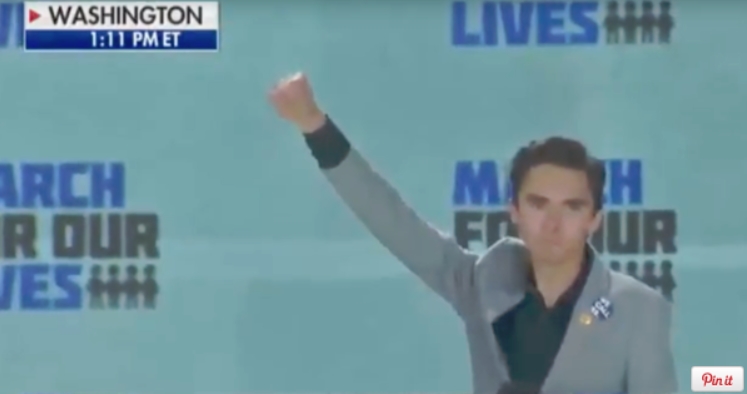 AmericanThinker.com – Mass hysteria and the anti-gun marches
AmericanThinker.com – Mass hysteria and the anti-gun marches
“Whip up fears, exploit panic, and assemble giant rallies where where mass hysteria powers a political movement to blame a chimera, and demand abrogation of existing rights: It’s a classic recipe for demogoguery. And the paradigmatic examples of demagogic politics in the modern era were the Nuremberg Rallies, held annually by the Nazi Party for a period of fifteen years in the 1920s and 1930s.
The rallies were mass events, attended by hundreds of thousands. Children – the Hitler Youth – were prominently featured, along with stagecraft and pageantry. The purpose of the rallies was to whip the masses into an emotional fervor while Hitler denounced the Jews.
It worked. And something similar is happening in the recent spate of children’s anti-gun marches, typified by the “March for Our Lives” just concluded in Washington, D.C.
The probability of getting struck by lightning is about the same as getting murdered by someone wielding a rifle. But you wouldn’t know that by listening to the demagogic (and obscene) little Parkland brats, Emma Gonzalez and David Hogg. They’re calling for a ban on America’s most popular rifle, the AR-15. Oddly enough, they don’t seem too concerned about the 64,000 annual deaths from overdoses, the 6,000-12,000 annual AIDS deaths, or 37,000 deaths in car crashes. The “March for Our Lives” is exposed as ridiculous, over-the-top hysteria when you logically look at the statistics of what is actually more likely to kill them.
But demagogic politics is not compatible with making sober public policy. Demagogic politics is about appealing to emotion, not logic. Once the masses have gotten whipped into an anti-gun hysteria, it won’t simply be a matter of banning some guns deemed “assault weapons.” Just as every Jew became a communist enemy to be eliminated, every gun will be subject to being banned or confiscated, too. Handguns will be next, because they are used in half of all homicides. After that will be registration of all shotguns and bolt-actions, right down to the .22 rimfire. The logical extension of the fanatical, intemperate anti-Jewish mob hysteria in Germany was not simply to stop communists, or even to stop communist Jews, but to make the Third Reich Judenrein. And the logical outcome of the fanatical, intemperate anti-gun mob hysteria is not school safety or stopping mass shootings; it is to make the U.S. gun-free.
We know this because we’ve already seen it in Great Britain, where all semi-automatics and handguns have been incrementally confiscated, and even pellet guns must be registered and licensed.
If we look at mass homicides in the U.K. since 1970, we find that 390 people have been killed with bombs and only 34 with handguns and “assault rifles.” Yet they banned the guns. Fancy that.
Banning guns requires the suspension of other civil liberties, too. Just as Jews in the Third Reich were summarily stripped of property, private property in the form of guns and magazines will be confiscated. Licensing and registering guns and requiring “mental health” evaluations will require warrantless searches of medical records. Due process will be eliminated for gun-owners. People’s homes will be raided by cops based on anonymous tips, which the Supreme Court has ruled constitute “probable cause.” And just as the Gestapo encouraged German citizens to report hidden Jews to the authorities, New York State offers a $500 reward to turn in anyone suspected of having a banned “assault weapon.”
In his expletive-laced rant, young Mr. Hogg stated, “Sadly … our parents don’t know how to use a f—— democracy, so we have to do it.”
But we do not live in a democracy. If the budding little child Führer from Parkland knew anything, he’d know that.
Plato warned us 2,500 years ago that democracies decay into demagogic dictatorships. Our nation’s founders took that lesson to heart and created a republic of limited powers and constitutional rights, not a democracy. John Adams wrote, “Remember, democracy never lasts long. It soon wastes, exhausts, and murders itself. There never was a democracy yet that did not commit suicide. It is in vain to say that democracy is less vain, less proud, less selfish, less ambitious, or less avaricious than aristocracy or monarchy…. Those passions are the same in all men, under all forms of simple government, and when unchecked, produce the same effects of fraud, violence, and cruelty.”
Our republican institutions are decaying into democratic demagoguery right before our very eyes. Not long ago, it would have been unimaginable for hundreds of thousands of people to be in the streets demanding the abridgment of a constitutionally enumerated right.
But here we are.
A Jew in Nuremberg in 1930 didn’t know exactly what was going to happen over the next fifteen years, but he was probably getting a sinking feeling that whatever it was, it wouldn’t be very good.
I am getting a bad feeling that whatever happens to our republic and our Constitution in the next fifteen years won’t be very good, either.”

